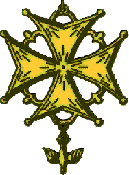The Huguenot Cross
History

While the origins of the Huguenot Cross are not completely certain, it seems probable that it was first produced in 1688 by a goldsmith with the name of Maystre or Mystre from the town of Nîmes near the southern coast of France. This was three years after Louis XIV had revoked the Edict of Nantes in October 1685, and Protestantism was thus declared to be illegal by what was known as the Edict of Fontainebleau. The Edict of Nantes had been issued on April 30th, 1598 by Henri IV to bring an end to the long Wars of Religion in France, and to give Protestants some freedoms and legal protection and rights.
The design is thought to derive from an official catholic and national decoration, the “Cross of the Order of the Holy Spirit” which had been worn by Henri IV, the king who had issued the Edict of Nantes to protect the Protestants.
The design is incorporated today into the official logo of the Reformed Church (l'Eglise Réformée de France).
Symbolism
The central part of the design is a Maltese Cross shape, representing the four-petalled Lily of France - golden-yellow irises that grow in the south of France. The four arms of the cross symbolise the four gospels. They lily itself symbolises purity.
The ends of each arm of the cross have a rounded design, which adds up to eight circles, representing the eight Beatitudes.
Between each of the arms of the central Maltese Cross, there are fleurs-de-lys, which are also a part of the French coat of arms, where the three parts of the fleur-de-lys represent the Holy Trinity. In the Huguenot Cross, the position of the fleurs-de-lys and their shape symbolises the spikes of the Crown of Thorns, representing the sufferings of Christ on the Cross.
The interior of each fleur-de-lys forms a heart shape, which is the symbol of faithfulness and loyalty. It may also be related to the form of the seal used by John Calvin.
The four fleurs-de-lys, each with three petals, adding up to a total of twelve petals, symbolises the twelve apostles.
The pendant is in the shape of a dove, which represents the Holy Spirit. In times of persecution, the dove pendant was replaced by a tear drop.




 Contact Us
Contact Us